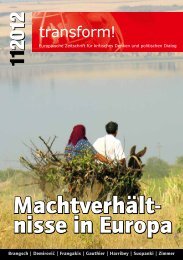A triumph of failed ideas European models of capitalism in ... - Journal
A triumph of failed ideas European models of capitalism in ... - Journal
A triumph of failed ideas European models of capitalism in ... - Journal
You also want an ePaper? Increase the reach of your titles
YUMPU automatically turns print PDFs into web optimized ePapers that Google loves.
Dom<strong>in</strong>ique Anxo.................................................................................................................................................................Although the re-orientation <strong>of</strong> macroeconomic and employment policydur<strong>in</strong>g this period might expla<strong>in</strong> the ‘Swedish success story’, themodifications <strong>in</strong> Swedish <strong>in</strong>dustrial relations – <strong>in</strong> particular, the cleartendency to re-coord<strong>in</strong>ate wage barga<strong>in</strong><strong>in</strong>g – without doubt played avital role <strong>in</strong> the Swedish recovery. These new developments reflected adesire on both sides <strong>of</strong> <strong>in</strong>dustry to re-coord<strong>in</strong>ate collective barga<strong>in</strong><strong>in</strong>g at<strong>in</strong>dustry level and restore the lead<strong>in</strong>g role <strong>of</strong> the traded good sectors <strong>in</strong>wage formation. The tendency towards a re-coord<strong>in</strong>ation <strong>of</strong> collectivebarga<strong>in</strong><strong>in</strong>g co-existed with a marked tendency to the decentralisationand <strong>in</strong>dividualisation <strong>of</strong> wage sett<strong>in</strong>g and work<strong>in</strong>g conditions.We also claimed that strong trade union organisations and high uniondensity at company level ensured the implementation <strong>of</strong> negotiatedforms <strong>of</strong> <strong>in</strong>dividualisation and differentiation (negotiated flexibility). Inour view, these tendencies should not be <strong>in</strong>terpreted as a weaken<strong>in</strong>g <strong>of</strong>the Swedish collective barga<strong>in</strong><strong>in</strong>g tradition, but rather as a recompositionand adaptation <strong>of</strong> the Swedish model <strong>of</strong> <strong>in</strong>dustrial relations <strong>in</strong> the face<strong>of</strong> the major transformations <strong>of</strong> work organisation and productionprocesses over recent decades. In our view, these developments did notcall <strong>in</strong>to question the basis <strong>of</strong> the Swedish model, namely a strongcontractual tradition based on the existence <strong>of</strong> powerful social partnerswho enjoy considerable autonomy from the public authorities, but<strong>in</strong>stead reflected a transition and adjustment <strong>of</strong> the Swedish model tothe new challenges posed by post-<strong>in</strong>dustrial societies.Also dur<strong>in</strong>g this period, the various reforms <strong>of</strong> the Swedish socialprotection system essentially took the form <strong>of</strong> a temporary reduction <strong>of</strong><strong>in</strong>come compensation and, perhaps with the exception <strong>of</strong> the fundamentalrestructur<strong>in</strong>g <strong>of</strong> the pension system, left the architecture <strong>of</strong> the Swedishwelfare state system almost <strong>in</strong>tact. The Swedish social protection systemrema<strong>in</strong>ed, by <strong>in</strong>ternational standards, clearly universal and <strong>in</strong>clusive <strong>in</strong>nature and still enjoyed a high level <strong>of</strong> across-the-board political andpublic support. The structural reforms undertaken <strong>in</strong> the tax and benefitsystem – <strong>in</strong> particular, the reshap<strong>in</strong>g <strong>of</strong> the pension system and the taxreform <strong>in</strong>itiated <strong>in</strong> the early 1990s aimed at strengthen<strong>in</strong>g work<strong>in</strong>centives and foster<strong>in</strong>g <strong>in</strong>vestment <strong>in</strong> human capital – was also clearly <strong>in</strong>l<strong>in</strong>e with the general philosophy <strong>of</strong> the orig<strong>in</strong>al Swedish model favour<strong>in</strong>gthe ‘work first l<strong>in</strong>e’, <strong>in</strong>tegrative transitions across the life course <strong>in</strong>stead <strong>of</strong>passive support and social exclusion.28 A <strong>triumph</strong> <strong>of</strong> <strong>failed</strong> <strong>ideas</strong> – <strong>European</strong> <strong>models</strong> <strong>of</strong> <strong>capitalism</strong> <strong>in</strong> the crisis








